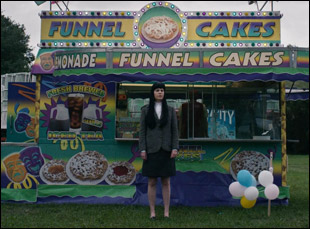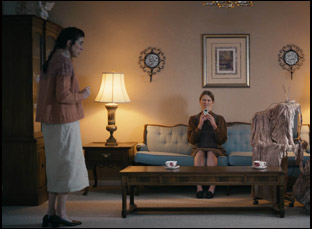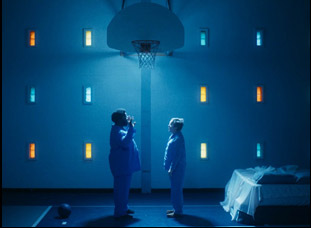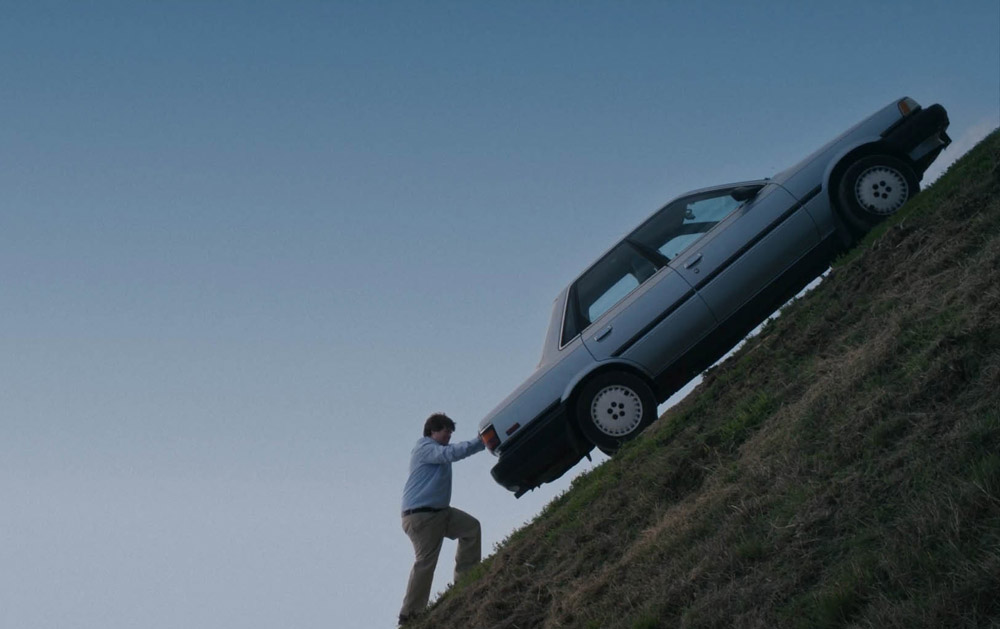You may wonder where you go after the nuclear mushroom cloud that opens “I’ve Got Issues,” but that curiosity is what makes the end feel like it’s just the beginning in the latest comedy from Steve Collins, whose films have long found hope in the most uncomfortable of places, even if he likes to see his characters struggle a bit. There are more of them than ever in his third feature, a shape-shifting hour-and-a-half in which the talented ensemble of actors he’s assembled over the years for various projects — Courtney Davis, John Merriman and Macon Blair, among the central core going back to his first feature “Gretchen” – play a variety of characters all grappling with some deep existential angst, with the minor indignities of breaking a heel on the way to work or having a car battery die add up to the feeling that the world is actively working against them.
Increasingly surreal imagery, ranging from tilt-a-whirls to Merriman gamely donning a suit entirely comprised of pizza cheese, begins to crop up as the mind begins to play tricks on its characters when the imagination begins to run wild with bad omen, but after locating fear as a common denominator, Collins starts taking back the absurd as a way to make sense of the topsy-turvy times we’re in as the ridiculous starts to turn into the sublime. With wry narration from Jim Gaffigan, “I’ve Got Issues” becomes cathartic in the laughs it has to offer, making great use of Austin, Texas, where much of Collins’ work has been set, both in its geography and its slightly askew perspective on the world and with the film now rolling out on digital and VOD, the writer/director spoke about how the nonlinear comedy took shape and being able to rely on an ever-growing company of ongoing collaborators to bring it to life.

I wrote it after the election happened when everyone was feeling like the world was going to end. With every new headline, it just seemed like things were getting worse and worse and I was trying to process with some comedy, but comedy that still took pain and hurt very seriously, which is what I’ve always done. In this case, this really is trying to reach a little more outward and make some comedy about institutions failing us, and not only politics, but the justice system, the art world, everything, so [I was keeping] a running list of things that were bothering me and trying to fix them through comedy. Now things that have gotten so much worse the film feels very prescient as if we predicted the world was going to end in a big fireball. But that wasn’t the original intention.
Things felt pretty bleak in 2016, as you remember, so that’s where it came from, and then I’ve been making shorts for years with the same group of actors and I wanted to do something more longform with them. A bunch of these shorts played at festivals and there was someone in the audience [at one] who suggested we make a feature. I thought that wouldn’t really work because of the episodic nature of what that would be, but later that night I thought, “Well, what if you could do something that was connected thematically instead of connected with one character or one single plot?” I thought of it like a puzzle, trying to work that out, and then I found that it maybe would be interesting if you thought all these things were separate, but then they all came together as some kind of metaphor for how we’re all alone in this world, but it would be a lot better if we were connected.

Absolutely. It was always conceived as a showcase for these particular actors and I never really thought twice about casting them in multiple roles because to me, it was like a sketch comedy show and a way for me to get people in a conversation more than getting them all wrapped up in a story in a fictional world. I really wanted to get them all to connect the themes between the stories, so using actors playing multiple roles was a way I thought I could do that. Everything was written for the actors’ strengths because I’ve been working with them for years and I’ve figured out what they can do very well and also what feels fresh for them. Like Paul Gordon, who’s a very gentle soul, plays this white supremacist CEO [in “I Have Issues”] and to have such a villainous character played by such a gentle person, I found to be interesting casting.
There were only a couple parts left, so we cast those — the parts that Claire Titelman plays — Ruth and Susan and a number of roles, that was also hard to find, but Claire fit in great with everyone else, and the part of Roy that’s played by Randy Aguebor, I hadn’t worked with Randy before, so we spent a lot of time trying to find him. He’s a unique guy, and is a very unique presence — he has what they call gravitas, a weight to him and it’s not just physical. When he started singing [in the audition], it really, really moved me. The lyrics I wrote for him were really quite ridiculous, but he moved me to the extent that I really didn’t find the lyrics ridiculous anymore and that’s what I wanted and what we tried to do in general is take these absurd premises and find the heart in them and the redemption or grace for these characters, so we’re not just putting weird things up on the screen to be weird, but really try to commit to them and rehabilitate them and find something beautiful in there. That’s what Randy did — he took my dumb songs and took every part he had and he added his soul to them, which you’re always in great debt to your actors for doing.

The post-production process was very difficult. It really was just removing a lot of pieces. What I learned was that as much as you try to get the audience to have a conversation with you, they get invested in characters and want to see characters grow and return, so we took out characters or vignettes that did not return. And there was a real section where I had written voiceover, which overtly talked about the role between comedy and despair, and I ended up removing it, realizing that I had overestimated the audience’s interest in having a didactic conversation. The movie is a comedy about despair, it’s a conversation enough. It doesn’t need to be said explicitly.
Of the movies I’ve done, I found this one the hardest to edit because of all the reasons in the Q & A when I told the person that asked the Q that it would not be a good idea to make a movie of many little shorts, that it would feel like stopping and starting, stopping and starting, and although we added a lot of solutions to that, I found that our first cut had that problem. But I’m quite happy with what we came up with.

We didn’t write for particular locations. That basketball church was just a little gift from God because in the script, it doesn’t really specify where the dream is happening, but we were going around Austin and on Guadalupe, there’s a mental health facility, just north of UT and they had this gym that was also doing double work as some kind of place of worship. I was so astounded by this location that we really worked hard to make sure they’d say yes and we could shoot there.
I did want to shoot in Austin because I do feel like even though Austin has changed so much, having shot many things there, I feel like I could find the middle America aesthetic that I wanted easier there than where I live in Connecticut. You could still find these dusty houses that have a a melancholy charm to them and it was nothing but luck with our locations. For the kind of emotions we’re trying to explore, I prefer the open landscape that you can find in Texas. These are movies about isolation, emotional isolation, so to be able to create images like that that have a lot of negative space is important. [Where I am now] you can’t see the sky. Everything’s all cramped together and hilly, so I was very eager to shoot in Texas. And in the beginning when we have what we call the suffering chorus suffering – Courtney walking with her broken heel and John pushing that car up that hill, those kinds of landscapes are very uniquely Texas. It’s gorgeous. I remember shooting some of that stuff and really saying to the DP [Nathan Smith], I really wish I lived out here still. I find it very therapeutic to have that open space.
“I’ve Got Issues” is now available on iTunes.




